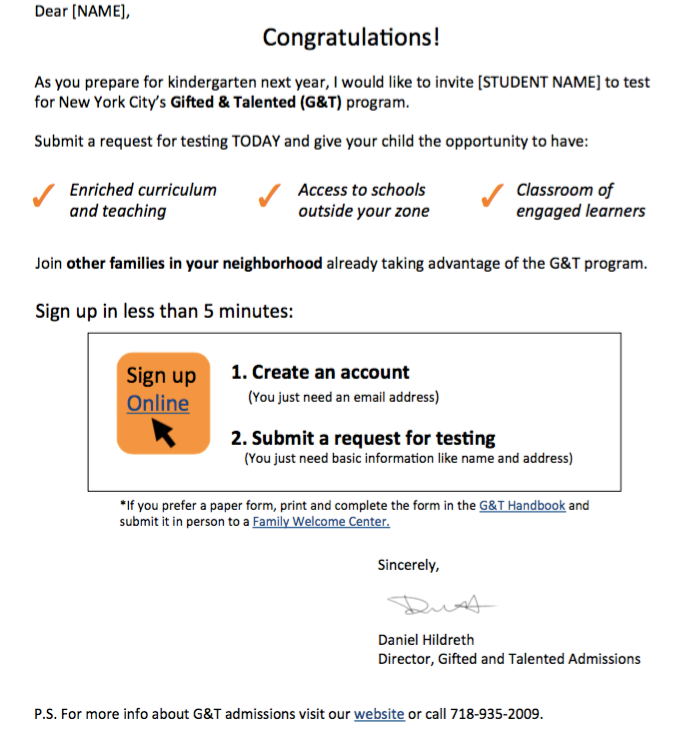
Targeted Emails Increase Interest in Gifted Education
Organization : ideas42
Project Overview
Project Summary
The New York City Department of Education redesigned emails to encourage preschool parents in low-income districts to sign their children up to take the Gifted and Talented admissions test.
Impact
The redesigned email increased requests for testing by 1.0 percentage point, a 9% increase over average submission rates in targeted districts.
Source
Source
Challenge
Students in low-income districts are less likely to sign up to take the Gifted and Talented (G&T) admissions test than their peers in higher-income districts. As a result, fewer students from low-income districts test into and attend G&T programs that could improve educational outcomes and provide meaningful opportunities. To the extent that the city may use sign-up rates as an indicator of demand, and thus where additional G&T programs should be located, low sign-up rates can mean fewer local G&T programs. If that lack of local G&T programs prompts fewer sign-ups, this can create a vicious cycle of under-utilization and compound inequitable education outcomes for students living in low-resource environments.
Close to 70,000 students enter kindergarten each year in NYC and can test for the first time into the G&T program. Informational emails and postcards had thus far failed to narrow the testing gap between districts.
Design
The Department of Education (DOE)’s Office of Student Enrollment worked with the NYC Behavioral Design Team to re-design its outreach materials for the G&T admissions test. The redesigned email used a congratulatory tone, highlighted the benefits of the G&T program, drove parents toward the least-hassling actions, used icons and succinct language to highlight key information and prompt action, and attempted to reframe the G&T program as one in which students from all neighborhoods participate.
Simplifying the information presented and drawing attention using colorful icons is particularly important for parents living with low incomes who are extremely bandwidth constrained. These salient cues help ensure the email is not easily ignored amongst the countless other draws on their attention.
Parents’ own experiences with the school system may decrease their comfort level and the perceived relevance of the G&T program. The outreach materials’ congratulatory tone, personalization, and clear description of program benefits empowered parents to take advantage of this opportunity.
Guiding parents toward online registration (with a clear indicator of how long it would take) helped people take action immediately, even if they were reading the email during non-business hours.

Original email

Redesigned email
The DOE identified a sample of families with children who would be in kindergarten the following academic year. The 66,625 families for whom the DOE had email addresses were randomly assigned to receive an original or redesigned email. Researchers then measured the number of families who signed up to take the Gifted and Talented test.
Impact
The DOE conducted a randomized control experiment to test the effectiveness of the redesigned outreach for the G&T admissions test and found that families who were sent the new email were 1.0 percentage point more likely to submit a request for testing (p<0.01) than those who received the original email. Among districts not targeted to boost testing requests, the average submission rate is 21%; thus, a one-percentage point increase represents a 5% increase in submission of testing requests. Although the redesigned email performed similarly in target districts, the relative impact is more meaningful because a one percentage-point increase over their average submission rate of 11% represents a 9% increase in submissions.
While the redesigned email was effective at getting more students to sign up for and show up to the Gifted and Talented test, the redesign did not lead to more students qualifying for the program. A combination of messaging to take the test and test preparation support may be more effective to close the achievement gap in qualification for Gifted and Talented programs.
Implementation Guidelines
Inspired to implement this design in your own work? Here are some things to think about before you get started:
- Are the behavioral drivers to the problem you are trying to solve similar to the ones described in the challenge section of this project?
- Is it feasible to adapt the design to address your problem?
- Could there be structural barriers at play that might keep the design from having the desired effect?
- Finally, we encourage you to make sure you monitor, test and take steps to iterate on designs often when either adapting them to a new context or scaling up to make sure they’re effective.
Additionally, consider the following insights from the design’s researcher:
- Sending out an email or letter? Consider using link shorteners to track click-through rates as proxy measures for your materials’ effectiveness. Also, make sure to check out B-Hub’s Best Practices checklist.
- While the Department of Education already used emails for outreach, designing and implementing the intervention incurred additional labor costs.
Project Credits
Researchers:
Natalie Dabney ideas42
Ted Robertson ideas42
Anthony Barrows ideas42
Jon Hayes ideas42
Rachel Rosenberg ideas42


